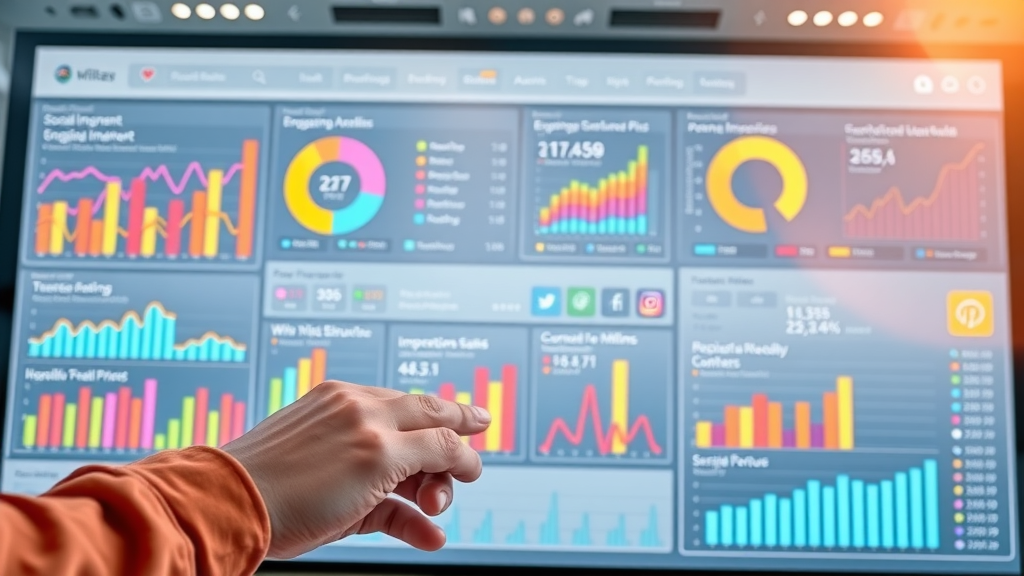
Did you know: Over 95% of Fortune 500 companies now leverage social media analytics, with brands reporting up to 22% higher ROI from advanced analytics solutions. The secret? Real-time social media data can spot trends before they go viral—putting you steps ahead of competitors. In this guide, we’ll expose the strategies, tools, and trends powering top brands, so you can turn digital data into business gold. Read on and unlock the analytics secrets industry leaders use daily!
Staggering Growth: Why social media analytics Matter More Than Ever
- Social media analytics adoption rates are soaring among Fortune 500 companies; Over 95% now use them.
- Brands using advanced social media analytics increase ROI by up to 22%.
- Real-time analytics identify trends before they go viral, providing competitive advantages.
The explosive adoption of social media analytics has shifted the competitive landscape for businesses worldwide. Latest data from global digital ad spends reveal a dramatic surge in analytics usage, with the past year seeing the majority of top social enterprises double down on these tools. In the United States and beyond, social media platforms serve as a primary connection between brands and audiences, making analytics more than just a feature—they’re a business necessity.
Not only do analytics tools uncover what your audience loves, but they also pinpoint which campaigns are driving true ROI. Data suggests that brands who invest in AI-driven analytics platforms can make informed, data-driven decisions—adjusting ad spend and content in real-time for maximum impact. As social platforms constantly evolve, leveraging the latest analytics ensures brands stay relevant, competitive, and profitable in a rapidly shifting digital environment.
Unlocking the Power of social media analytics: What You’ll Gain from This Guide
- Learn essential social media analytics concepts and benefits.
- Understand the role of generative ai in boosting analytics.
- Explore the impact of analytics on digital marketing and social media platforms.
- Master tools to measure and improve your social media performance.
- Grasp industry benchmarks and discover best practices.
This guide offers actionable takeaways for marketing leaders, content strategists, and business owners seeking to amplify their results with social media analytics. You’ll master key concepts, understand industry benchmarks, and discover best practices for integrating generative AI with your digital marketing. With step-by-step insights, you’ll learn how to interpret analytics data, optimize campaigns, and outmaneuver competitors in today’s dynamic digital ad landscape.
Whether you’re new to analytics or looking to elevate your skills, you’ll walk away with a toolkit for measuring success and supercharging ROI across every major media platform. Ready for a digital upgrade? Get equipped to win in 2024—and beyond.
Decoding social media analytics: Core Concepts for All Users
What is social media analytics? Defining the Foundation

Social media analytics refers to the processes and technologies used to collect, analyze, and interpret data generated from social media platforms. At its foundation, this discipline helps brands and organizations understand audience behavior, measure digital marketing campaign performance, and assess content effectiveness. In the past year, significant technological advances—particularly in artificial intelligence and user experience design—have transformed the power and granularity of these insights.
Analytics platforms can track everything from visitor traffic and engagement rates to sentiment analysis and trending topics. By leveraging both native and third-party analytics tools, organizations can identify the types of content that resonate most and drive action. User numbers for global social platforms are higher than ever, and with more data available, the accuracy and actionability of analytics insights have never been greater.
Understanding the basics of analytics is crucial for anyone looking to improve digital marketing ROI. These insights enable a data-driven approach, helping you adjust your strategy quickly, based on real, validated results rather than guesswork.
How social media analytics Empowers Data-Driven Decision Making
Modern businesses no longer rely on intuition alone; they look to social media analytics to guide their decisions. By analyzing high-volume data from various sources, digital marketing teams can gauge the health of campaigns, identify new opportunities, and pivot strategies in real-time. Analytics platforms also offer valuable historical data, so trends and patterns can be identified over multiple campaigns or years.
Data suggest that organizations equipped with robust analytics tools can outpace their competitors by rapidly recognizing shifts in user base behavior. Through real-time metrics and predictive algorithms, brands can make ad spend decisions grounded in evidence—optimizing resources and amplifying campaign effectiveness. This results in higher returns, reduced marketing waste, and far more impactful content.
With analytics-driven decisions, brands position themselves to adapt to changing platform algorithms, shifting media marketing trends, and evolving customer expectations. In essence, data becomes both your compass and your roadmap toward digital dominance.
The Relationship Between social media analytics and Digital Marketing

Social media analytics and digital marketing are intrinsically linked. Effective digital marketing strategies depend on precise, actionable insights into audience preferences, campaign performance, and channel effectiveness. With the increasing integration of search engines and social media platforms, analytics can bridge the gap by delivering a holistic view of user journeys—spanning from search engine queries to final conversions on social platforms.
According to the state of digital marketing in the United States, brands that integrate social media analytics with other tools—like search engine ad reports—experience higher ROI and faster time to value. By leveraging analytics across platforms, marketers capture a complete picture of visitor traffic, engagement, and conversion funnels.
Brands that monitor both social and search channels not only identify which campaigns drive results but also understand how content flows across the digital ecosystem. This user experience perspective lets teams unify their messaging, optimize ad spend, and foster stronger customer loyalty.
Integrating social media analytics with search engine Data for Greater Insights
Leading digital marketing experts recommend merging search engine and social media analytics for deeper, actionable insights. This approach enables marketers to compare which channels drive the most qualified leads, where users spend the most time, and how various ad formats impact conversion. Data traced across multiple touchpoints helps digital strategists attribute campaign success more accurately, supporting smarter ad spend decisions and campaign adjustments.
Analytics platforms increasingly allow direct integration with third-party sources, including Google Analytics, Facebook Insights, and more. This multi-source approach delivers granular reporting on visitor behavior, from initial search queries to social shares and purchases. For brands committed to staying ahead, adopting integrated analytics is the new gold standard for media marketing excellence.
social media analytics Platforms: Picking the Right Tool for Your Needs
Evaluating social media Platform Analytics: Facebook, Twitter, Instagram, LinkedIn, TikTok
Each social media platform offers unique analytics capabilities that suit different business goals. Facebook and Instagram excel in tracking engagement, follower growth, and ad performance with powerful native dashboards, while Twitter focuses on real-time conversation analysis and trending topics. LinkedIn analytics are tailored for B2B brands, emphasizing professional reach, employee advocacy, and industry thought leadership. TikTok provides insights into short-form video engagement and viral trends, key for reaching younger demographics.
When choosing analytics tools, consider ease of use, the depth of reporting, ability to handle multiple accounts, and integration options with other marketing software. Third-party platforms—like Sprout Social, Hootsuite, and Buffer—provide robust cross-platform reporting and predictive analytics powered by artificial intelligence, giving brands a performance edge.
For small businesses or teams with limited time, built-in analytics can be a cost-effective starting point. However, fast-growing brands often move to dedicated platforms that consolidate analytics, automate reporting, and deliver cross-platform intelligence for a more comprehensive view of digital marketing performance.
Comparison of Top social media analytics Tools and Their Features (Sprout Social, Hootsuite, Buffer, native platforms)
| Tool | Cross-Platform Support | AI Tool Integration | Automated Reporting | Best For |
|---|---|---|---|---|
| Sprout Social | Yes (All top social platforms) | Advanced (AI-driven insights) | Yes | Enterprise, Agencies |
| Hootsuite | Yes | Moderate | Yes | All Business Sizes |
| Buffer | Yes | Basic AI Overview | Yes | Small Businesses |
| Native Platforms | Single Platform | Limited | No | Individuals, Starters |
Utilizing generative ai for Enhanced social media analytics

The integration of generative AI into social media analytics has taken digital marketing to the next level. AI tools process massive volumes of data at warp speed, delivering deep, actionable insights that would be impossible for human analysts to spot alone. Pattern recognition, sentiment analysis, content recommendations, and even automated performance attribution have become not just possible, but practical, in the past year.
AI-driven analytics platforms can now predict which content will trend on a specific media platform or whether a particular campaign is likely to generate higher conversion rates. These capabilities empower marketers to proactively adjust their strategies, optimize ad spend, and ensure every piece of content delivers maximum impact across each social platform. For many, the result is more rapid scaling, lower digital ad waste, and better overall ROI.
"Harnessing artificial intelligence in social media analytics unlocks pattern recognition beyond human capacity." – Digital Marketing Thought Leader
As more platforms invest in AI integrations, expect the gap between top social performers and the rest of the market to widen. Adopting these next-gen tools isn’t just an advantage—it’s becoming a necessity.
Exploring the State of Digital social media Analytics: 2024 and Beyond
- Emerging generative ai trends
- Widespread real-time analytics
- Sophisticated performance attribution
In 2024, the state of digital analytics is marked by rapid evolution. Generative AI is at the forefront, providing smarter predictions for content and audience behavior. Real-time analytics adoption is now widespread, enabling brands to respond instantly to trending topics or viral challenges across any media platform.
Sophisticated performance attribution continues to mature, helping marketers link every digital ad or social post back to tangible business outcomes. This means clearer reporting for C-suite leaders and more targeted strategy for social media marketing teams. As analytics capabilities improve, expect brands to move away from vanity metrics toward deep, actionable intelligence to fuel their success.
social media analytics Metrics that Matter: What You Must Measure
- Engagement (likes, shares, comments)
- Reach and impressions
- Follower growth rate
- Click-through rates
- Conversion rates
- Video content performance
- Sentiment and brand mentions

Knowing which metrics to track is crucial for digital success. Engagement—measured by likes, shares, and comments—shows how your content resonates with your audience. Reach and impressions indicate the breadth of your content exposure, while follower growth rate helps you monitor how effectively you’re expanding your user base over time.
Click-through and conversion rates remain critical for tying social performance directly to digital ad ROI. For brands investing in video content, platform-specific metrics like watch time, retention, and completion rates offer a nuanced understanding of user experience and content success. Don’t overlook sentiment and brand mentions; these reveal how audiences feel about your brand, empowering you to shape strategy accordingly.
Industry benchmarks provide context for these metrics—helping you set achievable goals and tailor future campaigns for ongoing improvement in the rapidly shifting state of digital marketing.
Specific Metrics for Each social media Platform
Different social media platforms emphasize different analytics metrics. On Facebook and Instagram, engagement rate, reach, and ad spend effectiveness often dominate reporting. Twitter’s analytics focus on impressions, retweets, and trending hashtags, reflecting its role as a real-time global conversation hub. LinkedIn’s key metrics are unique: profile views, company follower growth, post engagement, and advanced search engine appearance stats.
TikTok provides detailed analysis of video content virality, including engagement by region, sound usage, and follower recommendations. Brands should align their analytics strategy with the specific strengths and content styles native to each social platform. By doing so, they’ll drive better results with less effort—ensuring resource allocation matches the platform’s unique user base and business goals.
Using advanced ai tool integrations, such as those in Sprout Social or Hootsuite, can help aggregate these metrics for seamless, cross-channel reporting—reducing time spent gathering data and allowing teams to focus on analysis and action.
Benchmarking with social media analytics: Setting Performance Standards
Key social media Benchmark Metrics for 2024 by Platform and Industry
| Platform | Engagement Rate Benchmark | Average Reach per Post | Conversion Rate | Industry Example |
|---|---|---|---|---|
| 1.2% | 8,000 | 2.1% | Retail (United States) | |
| 1.8% | 10,000 | 2.9% | Fashion | |
| 0.7% | 2,500 | 3.5% | B2B Tech | |
| TikTok | 4.1% | 20,000 | 1.7% | Entertainment |
Benchmarking is essential for contextualizing your social media analytics performance. By comparing your metrics to industry standards, you gain an honest view of where you lead, where you lag, and where improvement is possible. For instance, if your Instagram engagement rate is below 1.8% (the 2024 benchmark for fashion brands), it’s a call to tweak content or amplify ad spend.
As the state of digital marketing evolves, keeping pace with these benchmarks allows for smarter goal-setting, more efficient reporting, and continuous growth. Platforms and industries vary, so always align your benchmarks with your unique objectives and target audience.
Turning Data into Action: How to Use social media analytics for Results
- Identify best-performing content;
- Adjust campaign strategy in real-time;
- Align with broader digital marketing initiatives;
The real value of social media analytics lies in moving beyond passive observation to actionable insights . Once you’ve analyzed which posts outperform others, replicate and refine that content style across future campaigns. Use real-time analytics to pivot strategies instantly—shifting budgets toward high-performing platforms or ad formats.
Aligning social analytics data with broader digital marketing initiatives ensures every channel works cohesively. For example, if a piece of content trends on a top social platform, integrate it into your email marketing or search engine advertising. In the United States and globally, award-winning brands credit this data-driven agility as the bedrock of their ongoing success.
Root all decisions in data, not intuition. That’s how you translate digital ad insights into measurable business growth.
Case Studies: United States Brands Winning with social media analytics

Many leading brands across the United States have witnessed substantial improvements by harnessing the full spectrum of social media analytics. Take, for example, a top social retailer whose integrated analytics dashboard highlighted a sharp spike in user engagement after launching an influencer campaign. Swift analysis helped them pivot spend, amplifying reach by 35% and doubling conversions in just four weeks.
Another case: a B2B SaaS provider used advanced ai tool reporting to refine their LinkedIn strategy. By analyzing the state of digital engagement—even down to the user base’s occupation and region—they tailored content that resonated with decision-makers, boosting qualified leads by 89% over the past year. These brands’ experiences underscore the measurable results analytics can drive, no matter the industry.
The secret to their success? Making analytics central—not supplemental—to every digital strategy, from creative content planning to budget allocation.
The Role of Video Content in social media analytics Success
Analyzing Video Content Performance Across Leading Media Platforms
Video content has rapidly emerged as the most engaging format on nearly every social media platform. Analytics data consistently validate that short-form videos lead in both impressions and interaction rates. With media platforms like TikTok, Instagram Reels, and YouTube Shorts prioritizing video in their algorithms, mastering video analytics means unlocking a growth engine for your brand.
Advanced video analytics measure watch time, completion rates, user demographics, and more. These insights reveal not just what content is shared, but why it's successful—enabling marketers to replicate and scale viral success. AI-powered analytics platforms offer real-time feedback on content performance, guiding brands on optimal post timing, creative direction, and cross-posting opportunities.
"Short-form video remains the most engaging content type on all major social networks. Analytics can tell you what works – and why."
In an era where the average time spent on social platforms continues to rise, utilizing video analytics isn’t optional for serious brands—it’s essential.
Common Challenges in social media analytics—and How to Overcome Them
- Data overload
- Platform algorithm changes
- Privacy compliance
- Skills and technology gaps

As powerful as social media analytics have become, they present several challenges. Data overload is common, with teams drowning in more information than they can analyze. Additionally, platform algorithm changes can quickly render established strategies obsolete; staying flexible and regularly reviewing analytics is essential.
Privacy compliance is an ever-evolving concern, especially with rising regulations in the United States, United Kingdom, and globally. Brands must prioritize secure data practices and ensure analytics tools are compliant with the latest standards. Finally, a technology or skills gap can hold teams back from fully utilizing advanced ai tool features.
Overcome these barriers by investing in ongoing education, automating routine analytics tasks, and consulting with expert digital marketing partners. Staying proactive is the surest way to future-proof your analytics efforts.
Future-Proofing: Emerging Trends in social media analytics
- Growth of generative ai in analytics
- Deeper personalized insights
- Integration with other digital marketing platforms
The future of social media analytics is all about deeper personalization and seamless integration. Generative AI will continue to play a central role—enabling highly tailored insights down to individual preferences and regional trends. Data suggest an increasing blend of analytics systems, from social platforms to search engines and digital ad tools.
As organizations mature in their analytics adoption, expect to see more unified dashboards combining every touchpoint in the user journey. Personalization will shift from trend to expectation, with actionable insights delivered in real time and tailored to your industry, audience, and goals.
Embracing these trends now gives brands a head start, future-proofing digital strategies and ensuring sustained growth as technology rapidly evolves.
Frequently Asked Questions about social media analytics
How does social media analytics improve ROI?
By revealing which campaigns work, directing budget to most effective channels, and measuring conversions across platforms.
Smart brands rely on social media analytics to pinpoint which strategies drive revenue. By tracking results across every top social platform, analytics help refine ad spend, focus resources on what works, and eliminate ineffective campaigns. Over time, this data-driven approach leads to more efficient marketing budgets and a measurable boost in ROI.
Which social media analytics tool is best for small businesses?
Some leading options are Sprout Social, Buffer, and each platform’s in-built analytics; choice depends on business needs.
Small businesses often start with native analytics on platforms like Facebook or Instagram for basic insights. As needs grow, affordable third-party tools—such as Buffer or Sprout Social—provide greater flexibility, AI insights, and consolidated reporting for multiple accounts. The ideal choice depends on budget, team size, and which media platforms you prioritize.
Can social media analytics data be integrated with search engine advertising reports?
Yes, most analytics suites now allow direct integration for holistic digital marketing analysis.
Many leading analytics tools enable direct integration with search engine ad platforms, like Google Ads, for unified reporting. This allows for comprehensive comparison of campaign effectiveness, seamless adjustment of strategies, and efficient allocation of ad spend across all digital channels. Integrated analytics make it possible to attribute ROI to the correct channels and ensure that your digital marketing works in harmony.
Key Takeaways to Master social media analytics in 2024
- Advanced social media analytics drive business impact;
- Rapid adoption of generative ai is changing the landscape;
- Focus on actionable metrics;
- Regular benchmarking is critical
To truly unlock success in the state of digital marketing, marry advanced analytics with AI-powered insights. Track measurable, meaningful metrics—and never underestimate the power of frequent benchmarking to stay ahead. Action, not just analysis, will define who leads on every social media platform in 2024.
People Also Ask Section
What types of insights do social media analytics provide?
social media analytics provides in-depth insights into user engagement, audience demographics, campaign effectiveness, content performance, sentiment analysis, and competitive benchmarking. These insights empower data-driven content strategies and performance optimization.
With robust analytics, you can uncover detailed data on who is engaging with your content, when and why audiences interact with posts, and which campaigns resonate most. Analysis of sentiment and competitor activity further sharpens your market positioning. The result: smarter decisions and more targeted content, every time.
Why should brands prioritize social media analytics in 2024?
Prioritizing social media analytics ensures that brands stay ahead of trends, optimize resources, and boost ROI. Knowing what works—and what doesn't—can mean the difference between digital marketing success and irrelevance.
As the digital marketplace floods with content, only brands equipped with real-time analytics can confidently steer strategies. This proactive approach lets teams catch trends early, change campaigns promptly, and ensure maximum impact from every ad dollar spent. In short, analytics turn risk into opportunity.
Which platforms offer the most robust social media analytics features?
Meta (Facebook/Instagram), Twitter, LinkedIn, and TikTok all offer native analytics platforms, but third-party tools like Sprout Social and Hootsuite provide deeper, cross-platform insights and reporting.
The top social media platforms provide valuable built-in analytics for basic needs, but more advanced features—like AI-driven pattern recognition, predictive insights, and unified cross-platform dashboards—are only available in leading third-party tools. For maximum impact, many brands use a combination of both.
Take Your Results Further with Expert social media analytics Consulting
- Gain tailored recommendations for your industry
- Enhance your digital marketing maturity
- Learn how to leverage advanced tools and generative ai

If you want to accelerate results, consider partnering with professional consultants. Seasoned experts offer custom recommendations , industry-specific benchmarking, and top social platform insights tailored for your business. From mastering generative AI to optimizing ad spend strategies, expert guidance drives digital marketing maturity, helping you translate analytics into real competitive advantages.
With specialist support, you can navigate tools, technology changes, and new privacy regulations seamlessly—future-proofing your investment in digital success.
Ready to Unlock the Full Potential of social media analytics?
- Call us at (385) 469-1869 or email at info@solu4u.com today!
Turn today’s analytics data into tomorrow’s results: choose the right platforms, embrace AI, benchmark wisely, and take action. Don’t leave your brand’s future to chance—harness social media analytics now for lasting digital success.
Sources
- https://sproutsocial.com/insights/social-media-analytics/
- https://buffer.com/library/social-media-analytics/
- https://hootsuite.com/resources/social-media-analytics
- https://www.statista.com/topics/1164/social-networks/
- https://datareportal.com/reports/digital-2024-global-overview-report
To deepen your understanding of social media analytics, consider exploring the following authoritative resources:
-
“Social Media Analytics Guide for Brands and Marketing Teams” : This comprehensive guide delves into various types of social media analytics, including performance tracking, competitive analysis, social listening, sentiment analysis, influencer performance, and industry benchmarking. It provides actionable insights to help brands create accurate strategies and improve their social media presence. ( semrush.com )
-
“What Is Social Media Analytics? Social Media Analytics Definition” : This resource outlines the benefits of social media analytics, such as measuring ROI, understanding audience behavior, monitoring competitors’ campaigns, and making informed business decisions. It also discusses various social analytics tools and their applications. ( wix.com )
These resources offer valuable insights into leveraging social media analytics to enhance your brand’s digital marketing strategies.
 Add Row
Add Row  Add
Add 




Write A Comment